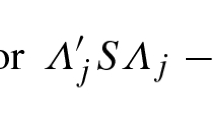Abstract
We describe a general procedure by which any number of parameters of the factor analytic model can be held fixed at any values and the remaining free parameters estimated by the maximum likelihood method. The generality of the approach makes it possible to deal with all kinds of solutions: orthogonal, oblique and various mixtures of these. By choosing the fixed parameters appropriately, factors can be defined to have desired properties and make subsequent rotation unnecessary. The goodness of fit of the maximum likelihood solution under the hypothesis represented by the fixed parameters is tested by a large samplex 2 test based on the likelihood ratio technique. A by-product of the procedure is an estimate of the variance-covariance matrix of the estimated parameters. From this, approximate confidence intervals for the parameters can be obtained. Several examples illustrating the usefulness of the procedure are given.
Similar content being viewed by others
References
Anderson, T. W.An introduction to multivariate statistical analysis. New York: Wiley, 1958.
Anderson, T. W., & Rubin, H. Statistical inference in factor analysis. In J. Neyman (Ed.),Proceedings of the Third Berkeley Symposium on Mathematical Statistics and Probability, Vol. V. Berkeley: University of California Press, 1956. pp. 111–150.
Fletcher, R., & Powell, M. J. D. A rapidly convergent descent method for minimization.Computer Journal, 1963,2, 163–168.
Holzinger, K. J., & Swineford, F.A study in factor analysis: The stability of a bi-factor solution. University of Chicago: Supplementary Educational Monographs, No. 48, 1939.
Howe, W. G. Some contributions to factor analysis. Report No. ORNL-1919, Oak Ridge National Laboratory, Oak Ridge, Tennessee, 1955.
Jöreskog, K. G. Testing a simple structure hypothesis in factor analysis.Psychometrika, 1966,31, 165–178.
Jöreskog, K. G. UMLFA — A computer program for unrestricted maximum likelihood factor analysis. Research Memorandum 66-20. Princeton, N. J.: Educational Testing Service. Revised Edition, 1967. (a)
Jöreskog, K. G. Some contributions to maximum likelihood factor analysis.Psychometrika, 1967,32, 443–482. (b)
Jöreskog, K. G., & Gruvaeus, G. RMLFA — A computer program for restricted maximum likelihood factor analysis. Research Memorandum 67-21. Princeton, N. J.: Educational Testing Service, 1967.
Jöreskog, K. G., & Lawley, D. N. New methods in maximum likelihood factor analysis.British Journal of Mathematical and Statistical Psychology, 1968,21, in press.
Kendall, M. G., & Stuart, A.The advanced theory of statistics, vol. 2. London: Charles Griffin and Co., 1961.
Lawley, D. N. Estimation in factor analysis under various initial assumptions.British Journal of Statistical Psychology, 1958,11, 1–12.
Lawley, D. N. Some new results in maximum likelihood factor analysis.Proceedings of the Royal Society of Edinburgh, Section A, 1967,67, 256–264.
Lawley, D. N., & Maxwell, A. E.Factor analysis as a statistical method. London: Butterworth, 1963.
Lawley, D. N., & Maxwell, A. E. Factor transformation methods.British Journal of Statistical Psychology, 1964,17, 97–103.
Lockhart, R. S. Asymptotic sampling variances for factor analytic models identified by specified zero parameters.Psychometrika, 1967,32, 265–277.
Reiersøl, O. On the identifiability of parameters in Thurstone's multiple factor analysis.Psychometrika, 1950,15, 121–149.
Thurstone, L. L.Multiple-factor analysis. Chicago: University of Chicago Press, 1947.
Thurstone, L. L., & Thurstone, T. G. Factorial studies of intelligence.Psychometric Monographs No. 2, 1941. Chicago: University of Chicago Press.
Tucker, L. R. An inter-battery method of factor analysis.Psychometrika, 1958,23, 111–136.
Tucker, L. R, Koopman, R. F., & Linn, R. L. Evaluation of factor analytic research procedures by means of simulated correlation matrices.Psychometrika, 1968, in press.
Vernon, P. E.The structure of human abilities. London: Methuen, 1951.
Author information
Authors and Affiliations
Additional information
This work was supported by a grant (NSF-GB 1985) from the National Science Foundation to Educational Testing Service.
Rights and permissions
About this article
Cite this article
Jöreskog, K.G. A general approach to confirmatory maximum likelihood factor analysis. Psychometrika 34, 183–202 (1969). https://doi.org/10.1007/BF02289343
Received:
Revised:
Issue Date:
DOI: https://doi.org/10.1007/BF02289343




